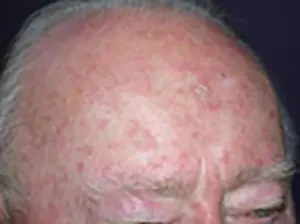Solar keratoses can progress to a type of skin cancer called squamous cell carcinoma (SCC).
The risk of squamous cell carcinoma occuring in a patient with more than ten solar keratoses is about 10-15%.
People with keratoses should visit their doctor regularly for examination as they are also at risk of developing SCC, BCC or Malignant Melanoma.
Treatment
Solar keratoses are usually treated because they are unsightly or uncomfortable, or because of the risk that skin cancer may develop in them. If a solar keratosis becomes thickened or tender it needs to be checked as it may have become a skin cancer.
Cryotherapy
Freezing with liquid nitrogen spray is an efficient and effective way to treat pre cancerous solar keratoses. The end result is blistering and crusting of the treated sunspots. Keratoses treated on the face heal after 5- 10 days, those on the rest of the body take longer – about 10–21 days. A short freeze is usually sufficient and leaves no scar, but more extensive freezing for thicker lesions or early skin cancers will result in a pale patch of skin replacing the sunspot.
Treatment for Solar keratoses is episodic – needing to be repeated every 6-12 months, depending of their number and severity.
If you have very extensive solar damage it is not practical or humane to freeze all the lesions. In this case a “field treatment” is needed.
Field Treatments for Sunspots
Field treatments involve using creams or light based treatments to areas with “wall to wall” keratoses. It is a more practical and humane way to treat patients with dozens or hundreds of SKs on their body.
They also has the advantage of being able to treat the entire sun damaged skin area– not just the scaly bits visible as the “tip of the iceberg”. Hence there is the possibility that such field treatments can prevent more skin cancers from forming than simple spot freezing. All treatments however have significant side effects— they form a surface“ burn” and need a dedicated patient to see the treatment through.
5-Flouro-Uracil cream (Efudix) is most useful when there are many keratoses on the face, scalp, arms or legs. The cream is applied onto facial skin once or twice daily for two to three weeks. The treated areas become red, raw and uncomfortable. Healing starts when the cream is discontinued, and the eventual result is usually much smoother skin.
Diclofenac in hyaluran gel has been used successfully to treat solar keratoses, with fewer reported side effects than Efudix. Its disadvantage is the long treatment regime – daily for up to 3 months.
Photo Dynamic Therapy (PDT) involves applying a photosensitizer (a porphyrin chemical) to the affected area prior to exposing it to a strong source of visible light. The treated area develops a burn and then heals over a couple of weeks or so.
